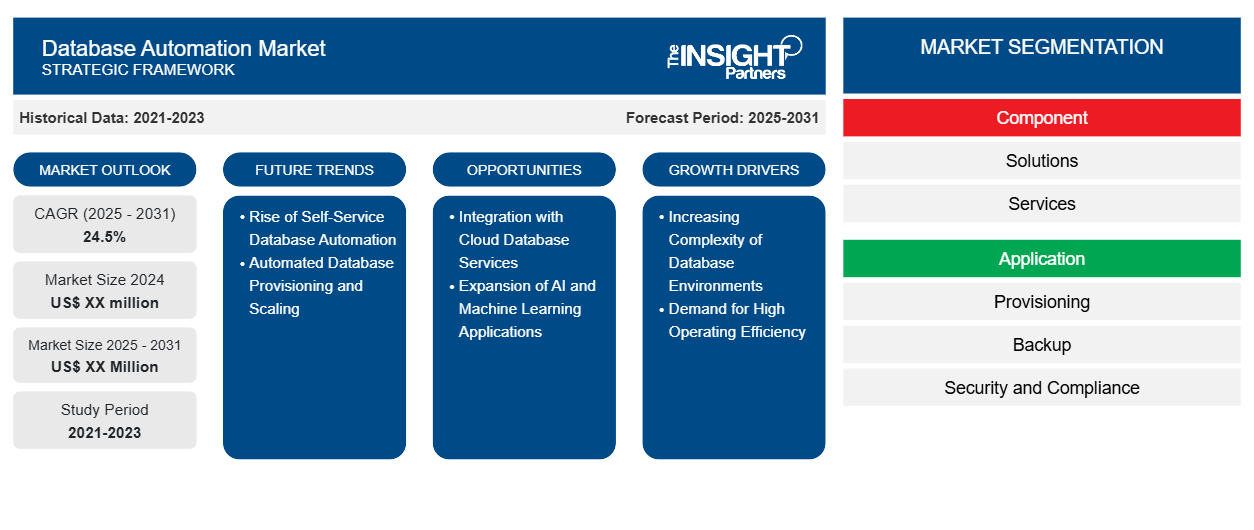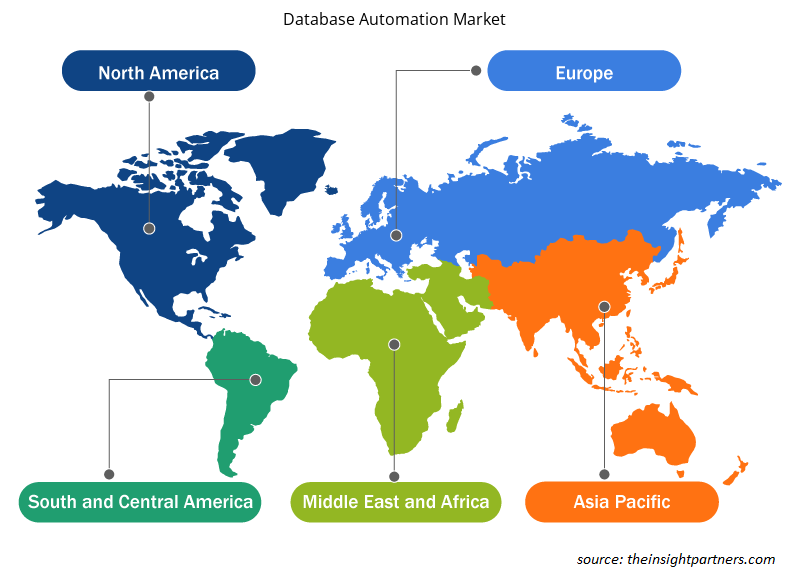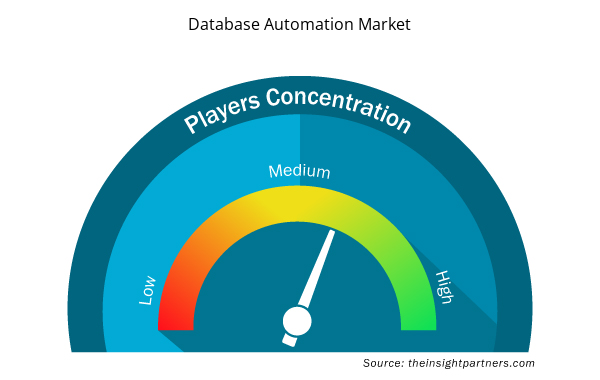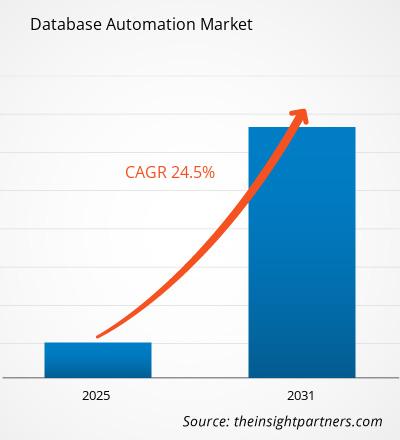Si prevede che il mercato dell'automazione dei database registrerà un CAGR del 24,5% dal 2025 al 2031, con una dimensione di mercato in espansione da XX milioni di dollari nel 2024 a XX milioni di dollari entro il 2031.
Il report è segmentato per Componente (Soluzioni, Servizi); Applicazione (Provisioning, Backup, Sicurezza e Conformità); Modalità di Distribuzione (Cloud, On-Premises); Dimensioni Aziendali (Grandi Imprese, PMI); Verticale (Produzione, Sanità, BFSI, Ricerca e Accademia, Media e Intrattenimento, Vendita al Dettaglio ed E-commerce, Governo e Difesa, Telecomunicazioni e IT, Altri); Geografia (Nord America, Europa, Asia-Pacifico, Medio Oriente e Africa, Sud e Centro America).
L'analisi globale è ulteriormente suddivisa a livello regionale e nei principali Paesi. Il report offre il valore in USD per l'analisi e i segmenti di cui sopra
Scopo del rapporto
Il report Database Automation Market di The Insight Partners mira a descrivere il panorama attuale e la crescita futura, i principali fattori trainanti, le sfide e le opportunità. Ciò fornirà spunti a vari stakeholder aziendali, come:
- Fornitori/produttori di tecnologia: per comprendere le dinamiche di mercato in evoluzione e conoscere le potenziali opportunità di crescita, consentendo loro di prendere decisioni strategiche informate.
- Investitori: condurre un'analisi completa delle tendenze relative al tasso di crescita del mercato, alle proiezioni finanziarie del mercato e alle opportunità esistenti lungo la catena del valore.
- Enti di regolamentazione: regolamentano le politiche e le attività di controllo sul mercato allo scopo di ridurre al minimo gli abusi, preservare la fiducia degli investitori e sostenere l'integrità e la stabilità del mercato.
Segmentazione del mercato dell'automazione del database
Componente
- Soluzioni
- Servizi
Applicazione
- Approvvigionamento
- Backup
- Sicurezza e conformità
Modalità di distribuzione
- Nuvola
- In sede
Dimensioni dell'impresa
- Grandi Imprese
- PMI
Verticale
- Produzione
- Assistenza sanitaria
- BFSI
- Ricerca e mondo accademico
- Media e intrattenimento
- Commercio al dettaglio ed e-commerce
- Governo e Difesa
- Telecomunicazioni e IT
- Altri
Personalizza questo report in base alle tue esigenze
Riceverai la personalizzazione gratuita di qualsiasi report, comprese parti di questo report, o analisi a livello nazionale, pacchetto dati Excel, oltre a usufruire di grandi offerte e sconti per start-up e università
Mercato dell'automazione dei database: approfondimenti strategici

- Scopri le principali tendenze di mercato in questo rapporto.Questo campione GRATUITO includerà analisi di dati che spaziano dalle tendenze di mercato alle stime e alle previsioni.
Fattori di crescita del mercato dell'automazione dei database
- Aumento della complessità degli ambienti di database: man mano che le organizzazioni adottano architetture di database più complesse, tra cui ambienti multi-cloud e ibridi, la gestione di questi sistemi diventa sempre più impegnativa. La necessità di una configurazione, un monitoraggio e una manutenzione efficaci dei database determina la domanda di soluzioni di automazione dei database. Gli strumenti di automazione semplificano le attività di gestione dei database, riducendo lo sforzo manuale necessario per garantire prestazioni, sicurezza e disponibilità ottimali dei database. Questa complessità è un fattore trainante primario alla base dell'adozione di tecnologie di automazione dei database.
- Richiesta di elevata efficienza operativa: le organizzazioni sono sempre alla ricerca di un miglioramento dell'efficienza operativa e di una riduzione dei costi correlati alla gestione del database. I processi dispendiosi in termini di tempo e soggetti a errori nell'amministrazione del database comportano maggiori spese generali nelle operazioni. Le organizzazioni possono liberare gli amministratori del database da attività banali come backup, patching e ottimizzazione delle prestazioni tramite soluzioni di automazione del database. La ricerca dell'efficienza operativa è un importante motore di mercato per la crescita del mercato dell'automazione del database.
Tendenze future del mercato dell'automazione dei database
- Ascesa dell'automazione dei database self-service: c'è una tendenza crescente verso l'automazione dei database self-service, che consente agli utenti dei database di eseguire attività di gestione senza dover dipendere pesantemente dai team IT. Le piattaforme self-service consentono agli utenti di automatizzare attività di routine, come provisioning, ridimensionamento e monitoraggio delle prestazioni, tramite interfacce intuitive e soluzioni low-code/no-code. Questa tendenza consente alle unità aziendali di assumersi la responsabilità dei propri ambienti di database, con conseguente miglioramento dell'agilità e tempi di risposta più rapidi alle esigenze aziendali.
- Provisioning e ridimensionamento automatizzati del database: gli strumenti di automazione vengono sempre più utilizzati per il provisioning e il ridimensionamento dei database in modo dinamico in base alla domanda. I database cloud-native, in particolare, traggono vantaggio da questa tendenza, adattandosi automaticamente alle fluttuazioni del carico di dati, del traffico o dei requisiti di risorse. Il provisioning automatizzato riduce il tempo impiegato per configurare manualmente i database, consentendo una distribuzione più rapida. Inoltre, l'automazione del ridimensionamento garantisce che i database rimangano performanti man mano che aumentano le richieste degli utenti, ottimizzando l'efficienza dei costi e l'utilizzo delle risorse durante il ciclo di vita del database.
Opportunità di mercato per l'automazione dei database
- Integrazione con Cloud Database Services: il passaggio al cloud computing offre molte opportunità per il mercato dell'automazione dei database. Man mano che le organizzazioni spostano i loro database in ambienti cloud, si crea la necessità di automatizzare soluzioni in grado di gestire i database cloud senza problemi. Le aziende che offrono prodotti di automazione dei database specificamente per i servizi cloud sarebbero in grado di capitalizzare tale domanda, consentendo alle organizzazioni di raccogliere i vantaggi di scalabilità, flessibilità e risparmi sui costi senza sacrificare la gestibilità.
- Espansione delle applicazioni di intelligenza artificiale e apprendimento automatico: l'incorporazione di intelligenza artificiale e apprendimento automatico nell'automazione del database ha una portata di crescita immensa in quanto aiutano a potenziare il processo tramite manutenzione predittiva, rilevamento delle anomalie e gestione intelligente ottimizzata dei dati. Le aziende che intendono potenziare l'efficienza e la robustezza del database hanno questa possibilità, con ciò che fornisce un vantaggio comparativo a un'azienda rispetto ad altre entità di mercato.
Approfondimenti regionali sul mercato dell'automazione dei database
Le tendenze regionali e i fattori che influenzano il Database Automation Market durante il periodo di previsione sono stati ampiamente spiegati dagli analisti di Insight Partners. Questa sezione discute anche i segmenti e la geografia del Database Automation Market in Nord America, Europa, Asia Pacifico, Medio Oriente e Africa e Sud e Centro America.

- Ottieni i dati specifici regionali per il mercato dell'automazione del database
Ambito del rapporto di mercato sull'automazione del database
| Attributo del report | Dettagli |
|---|---|
| Dimensioni del mercato nel 2024 | XX milioni di dollari USA |
| Dimensioni del mercato entro il 2031 | XX milioni di dollari USA |
| CAGR globale (2025 - 2031) | 24,5% |
| Dati storici | 2021-2023 |
| Periodo di previsione | 2025-2031 |
| Segmenti coperti | Per componente
|
| Regioni e Paesi coperti | America del Nord
|
| Leader di mercato e profili aziendali chiave |
|
Densità degli attori del mercato dell'automazione dei database: comprendere il suo impatto sulle dinamiche aziendali
Il mercato del Database Automation Market sta crescendo rapidamente, spinto dalla crescente domanda degli utenti finali dovuta a fattori quali l'evoluzione delle preferenze dei consumatori, i progressi tecnologici e una maggiore consapevolezza dei vantaggi del prodotto. Con l'aumento della domanda, le aziende stanno ampliando le loro offerte, innovando per soddisfare le esigenze dei consumatori e capitalizzando sulle tendenze emergenti, il che alimenta ulteriormente la crescita del mercato.
La densità degli operatori di mercato si riferisce alla distribuzione di aziende o società che operano in un particolare mercato o settore. Indica quanti concorrenti (operatori di mercato) sono presenti in un dato spazio di mercato in relazione alle sue dimensioni o al valore di mercato totale.
Le principali aziende che operano nel mercato dell'automazione dei database sono:
- Servizi Web Amazon, Inc.
- Azienda
- Disponibilità dati
- DBmaestro
- IBM
Disclaimer : le aziende elencate sopra non sono classificate secondo un ordine particolare.

- Ottieni una panoramica dei principali attori del mercato dell'automazione dei database
Punti di forza chiave
- Copertura completa: il rapporto copre in modo completo l'analisi di prodotti, servizi, tipologie e utenti finali del mercato dell'automazione dei database, fornendo una panoramica olistica.
- Analisi degli esperti: il rapporto è compilato sulla base della conoscenza approfondita di esperti e analisti del settore.
- Informazioni aggiornate: il rapporto garantisce la pertinenza aziendale grazie alla copertura di informazioni recenti e tendenze nei dati.
- Opzioni di personalizzazione: questo report può essere personalizzato per soddisfare le esigenze specifiche del cliente e adattarsi in modo appropriato alle strategie aziendali.
Il rapporto di ricerca sul Database Automation Market può, quindi, aiutare a guidare il percorso di decodifica e comprensione dello scenario del settore e delle prospettive di crescita. Sebbene possano esserci alcune preoccupazioni valide, i vantaggi complessivi di questo rapporto tendono a superare gli svantaggi.
- Analisi storica (2 anni), anno base, previsione (7 anni) con CAGR
- Analisi PEST e SWOT
- Valore/volume delle dimensioni del mercato - Globale, regionale, nazionale
- Industria e panorama competitivo
- Set di dati Excel



Report Coverage
Revenue forecast, Company Analysis, Industry landscape, Growth factors, and Trends

Segment Covered
This text is related
to segments covered.

Regional Scope
North America, Europe, Asia Pacific, Middle East & Africa, South & Central America

Country Scope
This text is related
to country scope.
Domande frequenti
Some of the customization options available based on the request are an additional 3-5 company profiles and country-specific analysis of 3-5 countries of your choice. Customizations are to be requested/discussed before making final order confirmation# as our team would review the same and check the feasibility
The report can be delivered in PDF/PPT format; we can also share excel dataset based on the request
Rise of Self-Service Database Automation is anticipated to play a significant role in the global Database Automation Market in the coming years
Increasing Complexity of Database Environments and Demand for High Operating Efficiency are the major factors driving the Database Automation Market
The Database Automation Market is estimated to witness a CAGR of 24.5% from 2023 to 2031
Trends and growth analysis reports related to Technology, Media and Telecommunications : READ MORE..
- Amazon Web Services, Inc.
- BMC Software, Inc.
- Datavail
- DBmaestro
- IBM
- Micro Focus
- Microsoft
- Oracle
- Percona
- Severalnines AB
The Insight Partners performs research in 4 major stages: Data Collection & Secondary Research, Primary Research, Data Analysis and Data Triangulation & Final Review.
- Data Collection and Secondary Research:
As a market research and consulting firm operating from a decade, we have published and advised several client across the globe. First step for any study will start with an assessment of currently available data and insights from existing reports. Further, historical and current market information is collected from Investor Presentations, Annual Reports, SEC Filings, etc., and other information related to company’s performance and market positioning are gathered from Paid Databases (Factiva, Hoovers, and Reuters) and various other publications available in public domain.
Several associations trade associates, technical forums, institutes, societies and organization are accessed to gain technical as well as market related insights through their publications such as research papers, blogs and press releases related to the studies are referred to get cues about the market. Further, white papers, journals, magazines, and other news articles published in last 3 years are scrutinized and analyzed to understand the current market trends.
- Primary Research:
The primarily interview analysis comprise of data obtained from industry participants interview and answers to survey questions gathered by in-house primary team.
For primary research, interviews are conducted with industry experts/CEOs/Marketing Managers/VPs/Subject Matter Experts from both demand and supply side to get a 360-degree view of the market. The primary team conducts several interviews based on the complexity of the markets to understand the various market trends and dynamics which makes research more credible and precise.
A typical research interview fulfils the following functions:
- Provides first-hand information on the market size, market trends, growth trends, competitive landscape, and outlook
- Validates and strengthens in-house secondary research findings
- Develops the analysis team’s expertise and market understanding
Primary research involves email interactions and telephone interviews for each market, category, segment, and sub-segment across geographies. The participants who typically take part in such a process include, but are not limited to:
- Industry participants: VPs, business development managers, market intelligence managers and national sales managers
- Outside experts: Valuation experts, research analysts and key opinion leaders specializing in the electronics and semiconductor industry.
Below is the breakup of our primary respondents by company, designation, and region:

Once we receive the confirmation from primary research sources or primary respondents, we finalize the base year market estimation and forecast the data as per the macroeconomic and microeconomic factors assessed during data collection.
- Data Analysis:
Once data is validated through both secondary as well as primary respondents, we finalize the market estimations by hypothesis formulation and factor analysis at regional and country level.
- Macro-Economic Factor Analysis:
We analyse macroeconomic indicators such the gross domestic product (GDP), increase in the demand for goods and services across industries, technological advancement, regional economic growth, governmental policies, the influence of COVID-19, PEST analysis, and other aspects. This analysis aids in setting benchmarks for various nations/regions and approximating market splits. Additionally, the general trend of the aforementioned components aid in determining the market's development possibilities.
- Country Level Data:
Various factors that are especially aligned to the country are taken into account to determine the market size for a certain area and country, including the presence of vendors, such as headquarters and offices, the country's GDP, demand patterns, and industry growth. To comprehend the market dynamics for the nation, a number of growth variables, inhibitors, application areas, and current market trends are researched. The aforementioned elements aid in determining the country's overall market's growth potential.
- Company Profile:
The “Table of Contents” is formulated by listing and analyzing more than 25 - 30 companies operating in the market ecosystem across geographies. However, we profile only 10 companies as a standard practice in our syndicate reports. These 10 companies comprise leading, emerging, and regional players. Nonetheless, our analysis is not restricted to the 10 listed companies, we also analyze other companies present in the market to develop a holistic view and understand the prevailing trends. The “Company Profiles” section in the report covers key facts, business description, products & services, financial information, SWOT analysis, and key developments. The financial information presented is extracted from the annual reports and official documents of the publicly listed companies. Upon collecting the information for the sections of respective companies, we verify them via various primary sources and then compile the data in respective company profiles. The company level information helps us in deriving the base number as well as in forecasting the market size.
- Developing Base Number:
Aggregation of sales statistics (2020-2022) and macro-economic factor, and other secondary and primary research insights are utilized to arrive at base number and related market shares for 2022. The data gaps are identified in this step and relevant market data is analyzed, collected from paid primary interviews or databases. On finalizing the base year market size, forecasts are developed on the basis of macro-economic, industry and market growth factors and company level analysis.
- Data Triangulation and Final Review:
The market findings and base year market size calculations are validated from supply as well as demand side. Demand side validations are based on macro-economic factor analysis and benchmarks for respective regions and countries. In case of supply side validations, revenues of major companies are estimated (in case not available) based on industry benchmark, approximate number of employees, product portfolio, and primary interviews revenues are gathered. Further revenue from target product/service segment is assessed to avoid overshooting of market statistics. In case of heavy deviations between supply and demand side values, all thes steps are repeated to achieve synchronization.
We follow an iterative model, wherein we share our research findings with Subject Matter Experts (SME’s) and Key Opinion Leaders (KOLs) until consensus view of the market is not formulated – this model negates any drastic deviation in the opinions of experts. Only validated and universally acceptable research findings are quoted in our reports.
We have important check points that we use to validate our research findings – which we call – data triangulation, where we validate the information, we generate from secondary sources with primary interviews and then we re-validate with our internal data bases and Subject matter experts. This comprehensive model enables us to deliver high quality, reliable data in shortest possible time.

 Ottieni un campione gratuito per questo repot
Ottieni un campione gratuito per questo repot